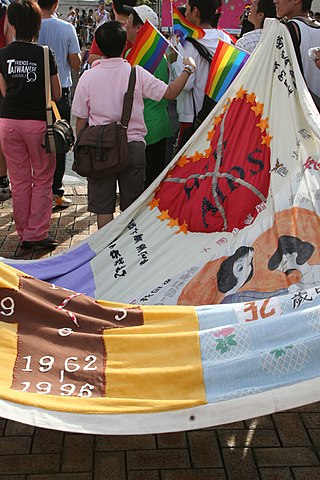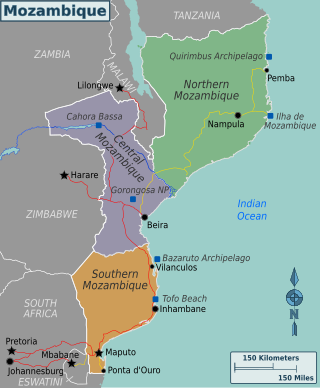Related Research Articles
The spread of HIV/AIDS has affected millions of people worldwide; AIDS is considered a pandemic. The World Health Organization (WHO) estimated that in 2016 there were 36.7 million people worldwide living with HIV/AIDS, with 1.8 million new HIV infections per year and 1 million deaths due to AIDS. Misconceptions about HIV and AIDS arise from several different sources, from simple ignorance and misunderstandings about scientific knowledge regarding HIV infections and the cause of AIDS to misinformation propagated by individuals and groups with ideological stances that deny a causative relationship between HIV infection and the development of AIDS. Below is a list and explanations of some common misconceptions and their rebuttals.

The global pandemic of HIV/AIDS began in 1981, and is an ongoing worldwide public health issue. According to the World Health Organization (WHO), by 2023, HIV/AIDS had killed approximately 40.4 million people, and approximately 39 million people were infected with HIV globally. Of these, 29.8 million people (75%) are receiving antiretroviral treatment. There were about 630,000 deaths from HIV/AIDS in 2022. The 2015 Global Burden of Disease Study estimated that the global incidence of HIV infection peaked in 1997 at 3.3 million per year. Global incidence fell rapidly from 1997 to 2005, to about 2.6 million per year. Incidence of HIV has continued to fall, decreasing by 23% from 2010 to 2020, with progress dominated by decreases in Eastern Africa and Southern Africa. As of 2020, there are approximately 1.5 million new infections of HIV per year globally.

The human immunodeficiency virus (HIV) is a retrovirus that attacks the immune system. It can be managed with treatment. Without treatment it can lead to a spectrum of conditions including acquired immunodeficiency syndrome (AIDS).

Taiwan's epidemic of HIV/AIDS began with the first case reported in December 1984. On 17 December 1990 the government promulgated the AIDS Prevention and Control Act. On 11 July 2007, the AIDS Prevention and Control Act was renamed the HIV Infection Control and Patient Rights Protection Act.
The Caribbean is the second-most affected region in the world in terms of HIV prevalence rates. Based on 2009 data, about 1.0 percent of the adult population is living with the disease, which is higher than any other region except Sub-Saharan Africa. Several factors influence this epidemic, including poverty, gender, sex tourism, and stigma. HIV incidence in the Caribbean declined 49% between 2001 and 2012. Different countries have employed a variety of responses to the disease, with a range of challenges and successes.

In Western Europe, the routes of transmission of HIV are diverse, including paid sex, sex between men, intravenous drugs, mother to child transmission, and heterosexual sex. However, many new infections in this region occur through contact with HIV-infected individuals from other regions. In some areas of Europe, such as the Baltic countries, the most common route of HIV transmission is through injecting drug use and heterosexual sex, including paid sex.
HIV/AIDS in China can be traced to an initial outbreak of the human immunodeficiency virus (HIV) first recognized in 1989 among injecting drug users along China's southern border. Figures from the Chinese Center for Disease Control and Prevention, World Health Organization, and UNAIDS estimate that there were 1.25 million people living with HIV/AIDS in China at the end of 2018, with 135,000 new infections from 2017. The reported incidence of HIV/AIDS in China is relatively low, but the Chinese government anticipates that the number of individuals infected annually will continue to increase.
Contaminated hemophilia blood products were a serious public health problem in the late 1970s up to 1985.

The situation with the spread of HIV/AIDS in Russia is described by some researchers as an epidemic. The first cases of human immunodeficiency virus infection were recorded in the USSR in 1985-1987. Patient zero is officially considered to be a military interpreter who worked in Tanzania in the early 1980s and was infected by a local man during sexual contact. After 1988—1989 Elista HIV outbreak, the disease became known to the general public and the first AIDS centers were established. In 1995-1996, the virus spread among injecting drug users (IDUs) and soon expanded throughout the country. By 2006, HIV had spread beyond the vulnerable IDU group, endangering their heterosexual partners and potentially the entire population.
The history of HIV/AIDS in Australia is distinctive, as Australian government bodies recognised and responded to the AIDS pandemic relatively swiftly, with the implementation of effective disease prevention and public health programs, such as needle and syringe programs (NSPs). As a result, despite significant numbers of at-risk group members contracting the virus in the early period following its discovery, Australia achieved and has maintained a low rate of HIV infection in comparison to the rest of the world.
Since the arrival of the HIV/AIDS epidemic in Italy in the 1980s, 120,000 cases of people testing positive for HIV have been registered with the Ministry of Health. Every year, 4,000 new infections are registered. Since the 1980s, 58,400 diagnoses of AIDS have been recorded, of which 35,300 have resulted in mortality. From the height of the epidemic in 1995 to today, the number of registered cases of AIDS has fallen from 5,600 to 1,200. The decline in incidence of AIDS is directly attributable to the efficacy of combined antiretroviral drug therapy, which has resulted in an increase in the number of people living with the diagnosis. The effectiveness of the drug therapy means that the 23,000 Italians diagnosed with HIV have better chances of not progressing to AIDS.

Mozambique is a country particularly hard-hit by the HIV/AIDS epidemic. According to 2008 UNAIDS estimates, this southeast African nation has the 8th highest HIV rate in the world. With 1,600,000 Mozambicans living with HIV, 990,000 of which are women and children, Mozambique's government realizes that much work must be done to eradicate this infectious disease. To reduce HIV/AIDS within the country, Mozambique has partnered with numerous global organizations to provide its citizens with augmented access to antiretroviral therapy and prevention techniques, such as condom use. A surge toward the treatment and prevention of HIV/AIDS in women and children has additionally aided in Mozambique's aim to fulfill its Millennium Development Goals (MDGs). Nevertheless, HIV/AIDS has made a drastic impact on Mozambique; individual risk behaviors are still greatly influenced by social norms, and much still needs to be done to address the epidemic and provide care and treatment to those in need.
UNAIDS has said that HIV/AIDS in Indonesia is one of Asia's fastest growing epidemics. In 2010, it is expected that 5 million Indonesians will have HIV/AIDS. In 2007, Indonesia was ranked 99th in the world by prevalence rate, but because of low understanding of the symptoms of the disease and high social stigma attached to it, only 5-10% of HIV/AIDS sufferers actually get diagnosed and treated. According to the a census conducted in 2019, it is counted that 640,443 people in the country are living with HIV. The adult prevalence for HIV/ AIDS in the country is 0.4%. Indonesia is the country in Southeast Asia to have the most number of recorded people living with HIV while Thailand has the highest adult prevalence.
HIV/AIDS in Jordan is characterized by a low prevalence rate compared to other regions, but the situation remains a concern due to potential for increase and the social and economic consequences that could result. As of 2007, the UNAIDS estimated that there were approximately 380 people living with HIV/AIDS (PLWHA) in Jordan. Despite the relatively low numbers, the country faces challenges in addressing the epidemic, including inadequate surveillance systems, limited adoption of preventive practices, and persistent stigma and discrimination against PLWHA.
Honduras is the Central American country most adversely affected by the HIV/AIDS epidemic. It is estimated that the prevalence of HIV among Honduran adults is 1.5%.
Nicaragua has 0.2 percent of the adult population estimated to be HIV-positive. Nicaragua has one of the lowest HIV prevalence rates in Central America.
With less than 1 percent of the population estimated to be HIV-positive, Egypt is a low-HIV-prevalence country. However, between the years 2006 and 2011, HIV prevalence rates in Egypt increased tenfold. Until 2011, the average number of new cases of HIV in Egypt was 400 per year, but in 2012 and 2013, it increased to about 600 new cases, and in 2014, it reached 880 new cases per year. According to 2016 statistics from UNAIDS, there are about 11,000 people currently living with HIV in Egypt. The Ministry of Health and Population reported in 2020 over 13,000 Egyptians are living with HIV/AIDS. However, unsafe behaviors among most-at-risk populations and limited condom usage among the general population place Egypt at risk of a broader epidemic.

With an estimated 150,000 people living with HIV/AIDS in 2016, Haiti has the most overall cases of HIV/AIDS in the Caribbean and its HIV prevalence rates among the highest percentage-wise in the region. There are many risk-factor groups for HIV infection in Haiti, with the most common ones including lower socioeconomic status, lower educational levels, risky behavior, and lower levels of awareness regarding HIV and its transmission.

HIV/AIDS was first detected in Canada in 1982. In 2018, there were approximately 62,050 people living with HIV/AIDS in Canada. It was estimated that 8,300 people were living with undiagnosed HIV in 2018. Mortality has decreased due to medical advances against HIV/AIDS, especially highly active antiretroviral therapy (HAART).
Since reports of emergence and spread of the human immunodeficiency virus (HIV) in the United States between the 1970s and 1980s, the HIV/AIDS epidemic has frequently been linked to gay, bisexual, and other men who have sex with men (MSM) by epidemiologists and medical professionals. It was first noticed after doctors discovered clusters of Kaposi's sarcoma and pneumocystis pneumonia in homosexual men in Los Angeles, New York City, and San Francisco in 1981. The first official report on the virus was published by the Center for Disease Control (CDC) on June 5, 1981, and detailed the cases of five young gay men who were hospitalized with serious infections. A month later, The New York Times reported that 41 homosexuals had been diagnosed with Kaposi's sarcoma, and eight had died less than 24 months after the diagnosis was made.
References
- ↑ "New HIV Infections Hit High in Japan". The Nation . 7 February 2007. Retrieved 18 December 2012.[ dead link ]
- ↑ "Everybody's talking sex in Japan, but nobody's hearing AIDS". Mainichi Daily News . 24 February 2004. Retrieved 18 December 2012.[ permanent dead link ]
- ↑ "HIV/AIDS Trends in Japan April 2016" (PDF). UNAIDS.
- 1 2 3 4 "HIV/AIDS in Japan, 2015". National Institute of Infectious Diseases. 37: 167–168. September 2016.
- ↑ Hiroshi, Yoshikura (2016). "Geo-Demography of HIV/AIDS in Japan from 1985 to 2011: Incidence and Transmission Mode under Influence of Population Size/Density". Japan Journal of Infectious Disease.
- 1 2 3 Kim, Young Soo (2015). "Japan Addresses the Global HIV/AIDS Crisis: The Roles of Media and Civil Society in Shaping Perceptions and Aid". Asian Perspective. 39 (3): 483–511. doi:10.1353/apr.2015.0021. S2CID 142420276. ProQuest 1704715108.
- ↑ "IASR 41(10), 2020【THE TOPIC OF THIS MONTH】HIV/AIDS in Japan, 2019". www.niid.go.jp. Retrieved 2023-06-11.
- ↑ "HIV/AIDS Country Profiles: Japan". Evidence to Action.
- ↑ Jaureguizar, Ibon Villelabeitia (March 27, 2017). "Japan Secures US$313 Million Contribution to the Global Fund". The Global Fund. Retrieved December 13, 2017.
- ↑ Japan Makes Significant Contribution to Global Fund
- ↑ Global Fund Welcomes Japan’s Commitment to Save One Million Lives